Nambu
World: Order of the Rising Sun (kyokujitsusho;
toyosho)

I have two of these. The first one
is, I think, post-war, while the second one I believe to be WWII-era
(specifically, 1939). There are eight classes of this medal, with only the
lowest two available to enlisted men. This one is the eighth class. I have read
that this award was given to both military and civilian recipients for general
merit. The name of this order is somewhat confusing. The top six classes are
called kyokujitsusho in Japanese and
translated as the Order of the Rising Sun in English. The seventh and eighth
classes, however, are called the to-yo-sho
in Japanese, which means “paulownia leaves medal” and is translated as
Decoration of the Paulownia Leaves in OMJAS. The seventh and eighth classes are
referred to by colour as well. The lowest one is the Order of the White
Paulownia Leaves (see case inscription below). The seventh class is the Order
of the Green Paulownia Leaves. Paulownia leaves are one of the symbols of the
Japanese Imperial Family. Below is the inscription on the back. It is exactly
the same as the one on the Order of the Sacred Treasure, 8th Class,
except that the characters are all written in one line. The order is from right
to left. It says kun-ko ki-sho, which
again means “meritorious deed ribboned medal”. This order is covered on pages
22-27 of OMJAS.

Here is the front of the case. From
top to bottom the characters read kun-hat-to-haku-shoku-to-yo-sho.
Literally that means “merit-eight-class-white-colour-paulownia-leaves-medal”.

This is the same medal, but I
believe it is an older, WWII-era one. The medal itself is the same, though this
one shows considerable wear to the ribbon. However, the box is different.

Here is the medal itself.
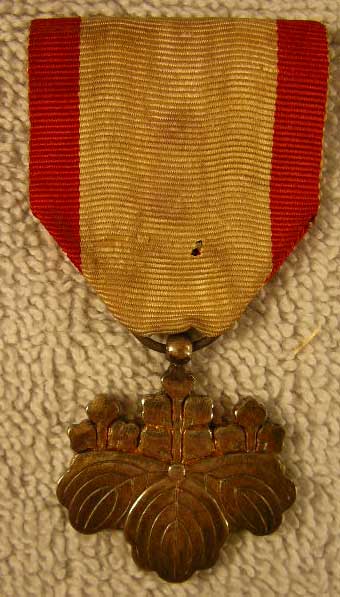
The back has the same inscription as the more
modern one.

The inner lining of the top of the box has come
loose.
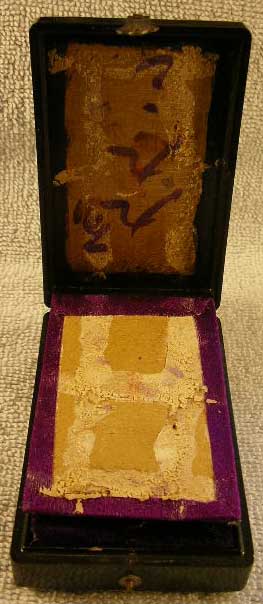
If you turn it around so the characters are
right side up, the two identical characters in the middle are 99, which I think
may be a reference to the year 2599 by the Japanese calendar, or 1939 in
Western style. The character in the upper right is the hiragana syllable ru, and the one at
the bottom looks like it may be shi.
They have no meaning themselves, so I suspect they may be some kind of
inspection marks.
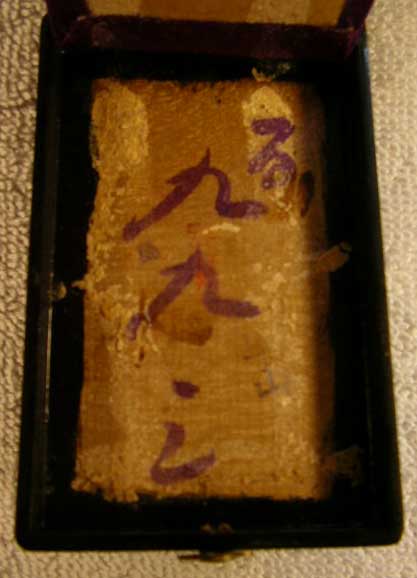
On the left is the older box with the
pin-and-hole clasp, while on the right is the newer one with the spring-loaded
closure (no clasp required).
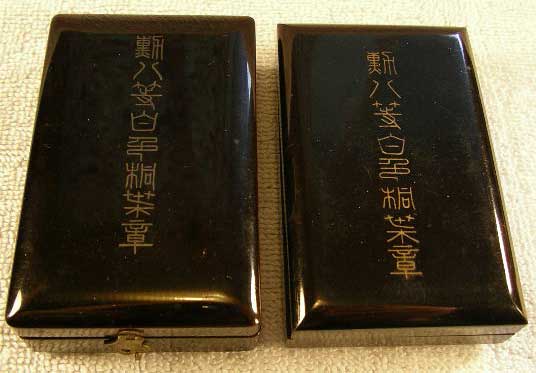
I have two kinds of certificates for
these medals. The first type is a small, simple certificate which specifies a
monetary award to go with the order. I have two of these. The second type is a
large, fancy presentation certificate that has the number of the
medal/certificate. I also have two of these. I have underlined the surnames in
the translations below.
First let’s look at the certificates
that specify monetary awards to go with the Order. They are relatively small.
Both mine are approximately 309mm by 228mm (12-3/16” by 9”). Both have
watermarks in the upper right and lower left corners and both have a purple
stamp on the back (all shown below).
This first certificate is for an 8th
Class Order of the Rising Sun awarded to Private First Class Matsunosuke Sato
on April 1, 1906 for service in the Russo-Japanese War.
Here is the Japanese:
First
column on far right: riku-gun-ho-hei-it-to-sotsu-sa-to-matsu-no-suke
Second
column from right: mei-ji-san-ju-shichi-hachi-nen-sen-eki-no-ko
[or isao]-ni
Third column
from right: yo-ri-kun-hat-to-haku-shoku-to-yo-sho
Fourth
column from right: oyobi-kin-hyaku-go-ju-en-o-u-ke-tama-u
Fifth
column from right: mei-ji-san-ju-kyu-nen-shi-gatsu-ichi-nichi
Last column
on left: sho-kun-kyoku-so-sai-jun-ni-i-kun-it-to-shi-shaku-dai-kyu-tsune*
My translation is: “Army Infantry
Private First Class Matsunosuke Sato: for meritorious conduct during the
Meiji 37-8 [1904-05] campaign, the Emperor bestows the Eighth Class Order of
the White Paulownia Leaves and the sum of 150 yen. April 1,
Meiji 39 [1906]. President of the Board of Decorations
Viscount Tsune Daikyu, Junior Second Rank, Holder of the First Order of
Merit”. The hardest part of this is the last column. The Viscount’s
surname has over a dozen possible pronunciations, most likely Daikyu or
Okyu. His given name also has several possible pronunciations: Tsune, Hisashi,
Hitoshi and Wataru, for example. Since he was a big shot, I may eventually be
able to look him up in a Who’s Who-type directory in
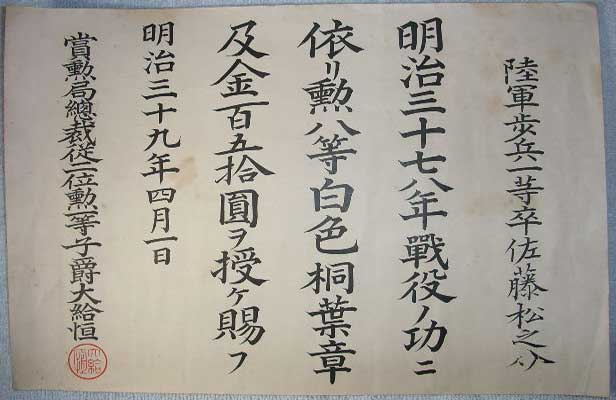
The upper right has a watermark of paulownia
leaves, one of the symbols of the Imperial family.
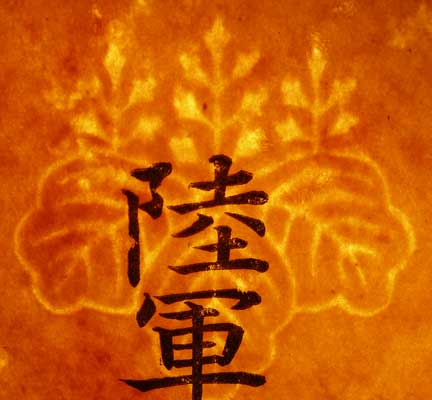
This is the much smaller watermark
in the lower left. It is a sakura
(cherry) blossom with the character in (short
for insatsu=printing) inside it. I
think that means the certificate was printed by the Government Printing
Department of the Empire of Greater Japan.
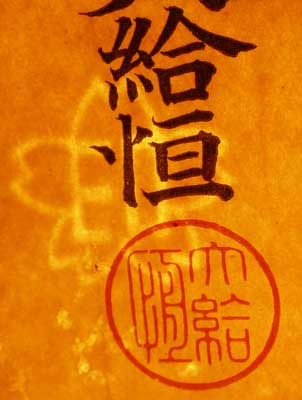
Here is a close-up of a purple stamp
on the back (lower left corner) of the certificate. The writing in the outer
circle indicates it was stamped on September 5, Meiji 39 (1906) and has the
notation “page 35”. The writing on the middle says kan-po go-gai, “special issue of the official gazette”. The stamp
is 24mm (one inch) in diameter.

This second small certificate was
awarded to Mr. Yoshitaro Nomura along with an Eighth Class Order of the Rising Sun and 250 yen in
cash on December 15, 1919. Given the date, it probably related to service with
the Japanese intervention force in
Here is the Japanese:
First
column on far right: riku-gun-jo-to-kan-go-sotsu-no-mura-yoshi-ta-ro
Second
column from right: sen-eki-no-ko [or
isao] ni-yo-ri-kun-hat-
Third
column from right: to-haku-shoku-to-yo-sho-oyobi
Fourth
column from right: kin-ni-hyaku-go-ju-en-o-u-ke
Fifth
Column from right: tama-u
Sixth
column from right: tai-sho-hachi-nen-ju-ni-gatsu-ju-go-nichi
Last column
on left: sho-kun-kyoku-so-sai-sho-yon-i-kun-ni-to-haku-shaku-ko-dama-hide-o
My translation is: “Army Superior
Grade Medic Yoshitaro Nomura: For meritorious conduct during wartime the
Emperor bestows the Eighth Class Order of the White Paulownia Leaves and the
sum of 250 yen. December 15, Taisho 8 [1919]. President of the Board of Decorations Count Hideo Kodama, Fourth
Rank, Holder of the Second Order of Merit.” The red stamp in the corner
says “Seal of the President of the Board of Decorations”. These seals are often
used even today in place of signatures in
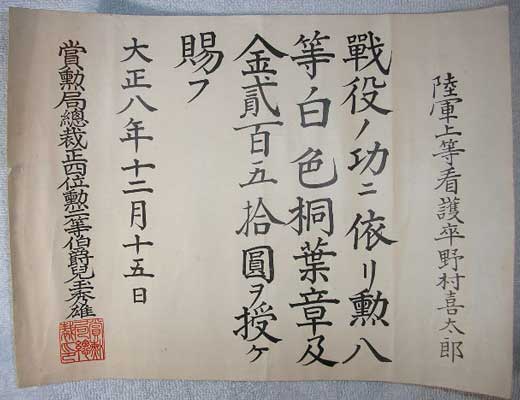
Here is the stamp on the back (lower
left corner). It is 24mm in diameter, the same as the other one shown above.
The date around the outside is January 24, Taisho 9 (1920). The outer edge also
has the notation “page 2”. The writing in the centre says

Now let’s look at the larger,
presentation certificates. I have two, which differ primarily in the artwork at
the bottom centre. This is the earlier one. It is 584mm X 450mm (23” X 17-3/4”)
and made of fairly heavy-weight paper. There are watermarks in the upper right
and lower left corners (shown below). There is nothing written or stamped on the
back.
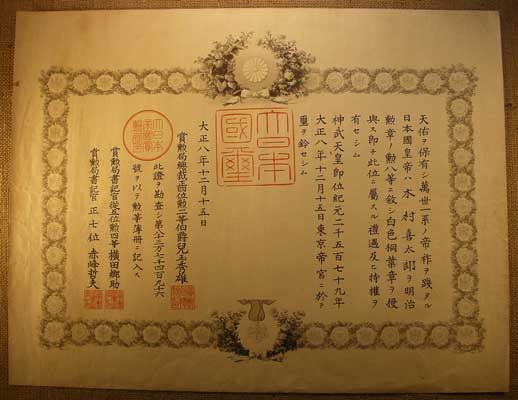
The most important information is on
the right side, which records the recipient’s name and the date of the award.
The writing is in vertical (top down) columns, starting at the right and
working across towards the left. Here is the text in Japanese, followed by a
translation:
First column on
right: ten-yu-o-ho-yu-shi-ban-sei-ik-kei-no-tei-so-o-fu-taru
Second column from right: nippon-koku-ko-tei-wa-ki-murai-ki-ta-ro-o-mei-ji
Third column from right: kun-sho-no-kun-hat-to-ni-jo-shi-haku-shoku-kun-sho-o-ju
Fourth column from right: yo-su-sunawa-chi-kono-i-ni-zoku-suru-rei-gu-oyo-bi-tok-ken-o
Fifth column from right: yu-seshimu
Sixth column from right: jim-mu-ten-no-soku-i-ki-gen-ni-sen-go-hyakunana-ju-kyu-nen
Seventh column from the right: tai-sho-hachi-nen-ni-gatsu-ni-ju-go-nichi-to-kyo-tei-kyu-ni-oi-te
Last column on left: ji-o-?-seshimu [I could not identify the third symbol from the top, though the meaning is clear both from the context and the OMJAS translation].
I was somewhat lucky because OMJAS translates a certificate for another order on pages 20-21. However, I have not followed their translation very closely. Anyway, here is my translation:
“The Emperor of

The left side has the formalities
from the Board of Decorations. Surnames are underlined in the following
translations. The big round red seal at the top says dai-nip-pon-tei-koku-sho-kun-kyoku-in, “Seal of the Board of
Decorations of the Empire of Greater Japan”. The first column on the right has
the date, December 15, Taisho 8 (1919). The second column says sho-kun-kyoku-so-sai-sho-yon-i-kun-ni-to-haku-shaku-ko-dama-hideo:
“President of the Board of Decorations Count Hideo Kodama, Fourth Rank,
and holder of the Second Order of Merit. The third and fourth columns say kono-sho-kan-sa-shi-dai-hachi-ju-san-man-nana-sen-yon-byaku-kyu-ju-roku-go-o-motte-kun-to-bo-satsu-ni-ki-nyu-su:
“We have entered number 837496 in the Register of Grades of Merit” (this is the
number of the certificate). The second last column on the left says sho-kun-kyoku-sho-ki-kan-ju-go-i-kun-yon-to-yoko-ta-go-suke:
“Secretary of the Board of Decorations Gosuke Yokota, Junior Fifth Rank,
Holder of the Fourth Order of Merit”. The last line is
sho-kun-kyoku-sho-ki-kan-sho-nana-i-aka-mine-tetsu-o: “Secretary of the Board
of Decorations Tetsuo [given name could also be Akio, Sato or Toshio] Akamine,
Junior Seventh Rank”. The square-ish red seals at the bottom repeat the titles
(President and Secretary) of the individuals whose names are affixed. Such seals
are often used instead of signatures in
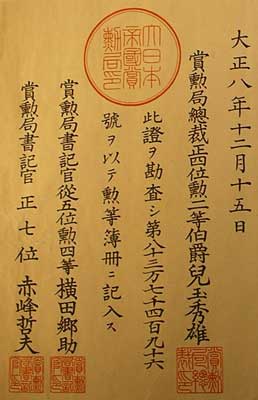
Here is a close-up of the artwork in the top middle
of the certificate, with the Imperial chrysanthemum in the centre.

The big red seal in the centre reads
from upper right down, then upper left down. First (right) column: dai-nip-pon. Second (left) column: koku-ji. Together it means “Imperial
Seal of Greater Japan”. The kanji in the lower left, ji=Emperor’s seal, gave me some trouble, as it is rather rare and
written in an ancient fancy script style. I finally realized that it was the same
as a printed character on the right side of the certificate and was able to
find it on page 55 of Nelson’s Japanese-English
Character Dictionary, Second Revised Edition, where it is kanji #71.
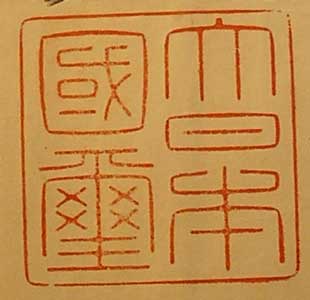
Here is a close-up of the artwork in
the bottom centre. Note that this is different from the one on the later
certificate shown below (the ribbon is different and the later one is in
colour).

Here is the lower left corner, showing that the border is made up of alternating chrysanthemums and paulownia leaves, both symbols of the Imperial family.
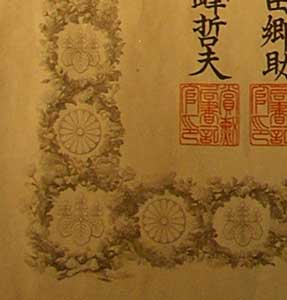
This is the watermark in the upper
right corner. It is the Imperial Chrysanthemum. The photo appears off-colour
because I had to put an incandescent lamp directly behind the certificate to
get the watermark to show up and to have enough light to get a shutter speed
that would allow a clear, sharp shot.
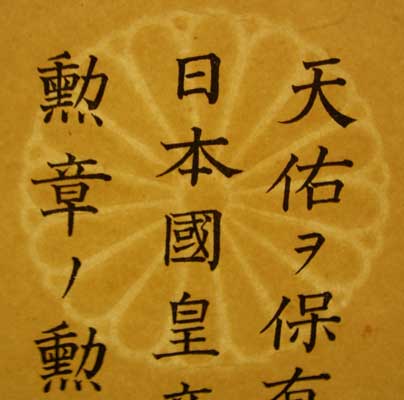
This is the much smaller watermark
in the lower left. It is a sakura
(cherry) blossom with the character in (short
for insatsu=printing) inside it. I
think that means the certificate was printed by the Government Printing
Department of the Empire of Greater Japan.

This is the second large presentation certificate I have. It is not the same size as the earlier one for the same medal. This one is 592mm X 418mm (23-5/16” X 16-7/16”). It has the usual two watermarks in the upper right and lower left, and a small pencil notation of the recipient’s name on the back (shown below).
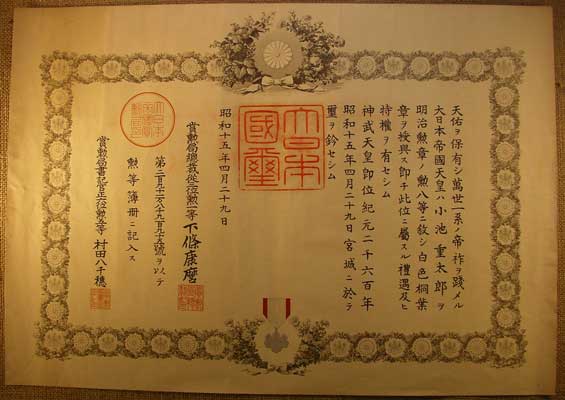
The right side has the important information, i.e. the recipient’s name and the date. The wording is slightly different from the earlier certificate shown above, so here is the whole thing, first in Japanese, then in English. The Japanese wording differs in the terms used for the Emperor and the Palace, but is otherwise pretty much the same.
First column on far right: ten-yu-o-ho-yu-shi-ban-sei-ik-kei-no-tei-so-o-fu-meru
Second column from right: dai-nip-pon-tei-koku-ten-no-wa-ko-ike-ju-ta-ro-o
Third column from right: mei-ji-kun-sho-no-kun-hat-to-ni-jo-shi-haku-shoku-to-yo
Fourth column from right: sho-o-ju-yo-su-sunawa-chi-kono-i-ni-zoku-suru-rei-gu-oyo-bi
Fifth column from right: tok-ken-o-yu-seshiumu
Sixth column from right: jim-mu-ten-no-soku-i-ki-gen-ni-sen-rop-pyaku-nen
Seventh column from right: sho-wa-ju-go-nen-shi-gatsu-ni-ju-kyu-nichi-kyu-jo-ni-oi-te
Last column on left: ji-o-[?]-seshimu
My translation is:
“The Emperor of Greater Japan, having come to the Imperial
throne in an unbroken Imperial line with divine guidance, confers the Meiji
Order of Merit, Eighth Class, and awards the Order of the White Paulownia
Leaves to Jutaro Koike [surname Koike] along with the honours and
privileges appurtenant thereto. The Imperial Seal has been affixed in the
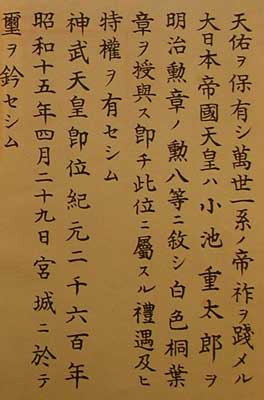
The left side has the formalities
from the Board of Decorations. Surnames are underlined in the following
translations. The big round red seal at the top says dai-nip-pon-tei-koku-sho-kun-kyoku-in, “Seal of the Board of
Decorations of the Empire of Greater Japan”. The first column on the right has
the date, April 29, Showa 15 (1940). The second column says sho-kun-kyoku-so-sai-ju-san-i-kun-it-to-shimo-jo-yasu-maro:
“President of the Board of Decorations Yasumaro Shimojo, Junior Third
Rank, and Holder of the First Order of Merit. The third and fourth columns say dai-ni-hyaku-kyu-ju-ichi-man-has-sen-kyu-hyaku-kyu-ju-go-go-o-motte-kun-to-bo-satsu-ni-ki-nyu-su:
“We have entered number 2918995 in the Register of Grades of Merit” (this is
the number of the certificate). The second last column on the left says sho-kun-kyoku-sho-ki-kan-sho-roku-i-kun-go-to-mura-ta-ya-chi-o
[or –ho]: “Secretary of the Board
of Decorations Yachio Murata, Sixth Rank, Holder
of the Fifth Order of Merit”. The square-ish red seals at the bottom repeat the
titles (President and Secretary) of the individuals whose names are affixed.
Such seals are often used instead of signatures in
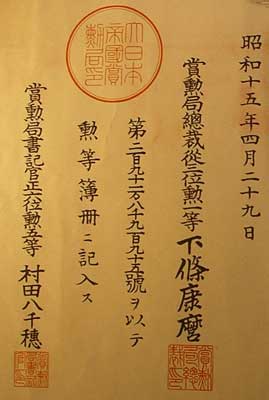
As previously mentioned, the artwork in the bottom centre of the certificate is different from the earlier certificate shown above. Note that the ribbon is now in colour and its shape is as it is on the medals, not the stylized loose ribbon shown on the earlier style of certificate.
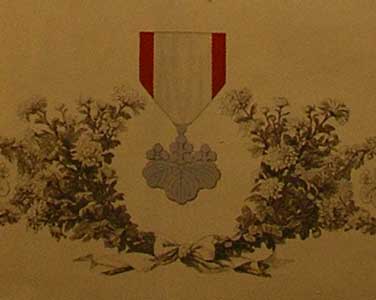
These characters were pencilled in on the back near the left edge. Read from top to bottom, they are Koike Jutaro, the name of the recipient.
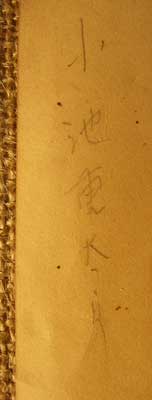
To
return to the base page on Medals, please click here: Nambu
World: Japanese Medals
To return to “Other Japanese Militaria”,
please click here: Nambu
World: Other Japanese Militaria
To return to the home page, please
click here: Nambu World: Teri’s WWII Japanese
Handgun Website
Last updated: July 31, 2006. All contents are copyright Teri unless
otherwise specified and may not be used elsewhere in any form without prior
permission.